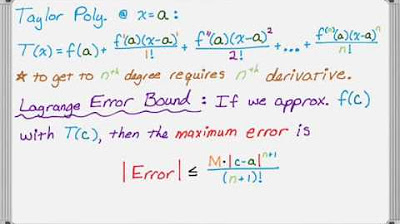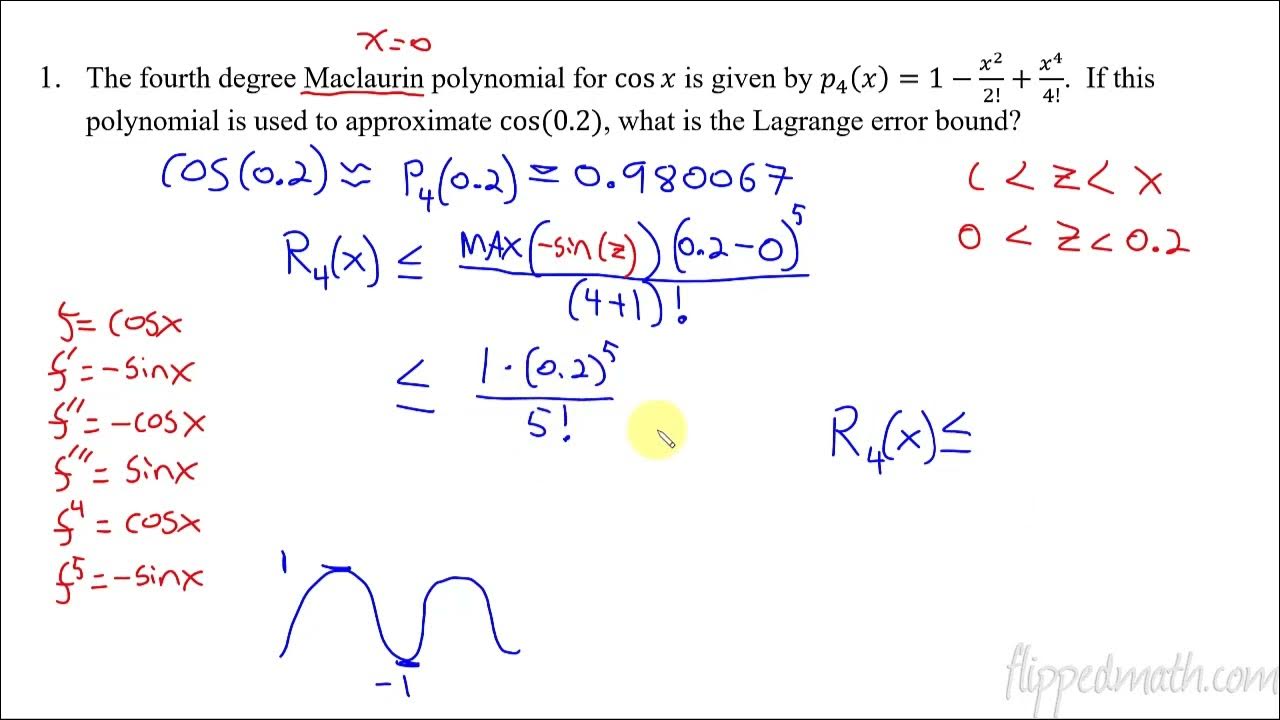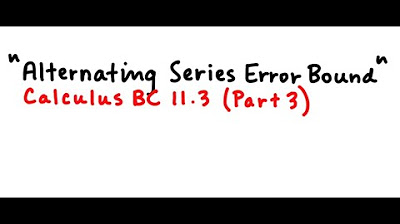Taylor's Remainder Theorem
TLDRThis video script explains the process of calculating the maximum error of an approximation using Taylor's Remainder Theorem. It walks through the steps of determining the necessary derivatives, evaluating them at specific points, and applying the theorem formula to find the maximum error for approximating the natural log of 1.1 and the square root of 1.2. The video also demonstrates how to calculate the exact error by comparing the approximation to the actual function values, showing that while the exact error is less than the maximum error, it is still close.
Takeaways
- 📚 Taylor's Remainder Theorem is used to calculate the maximum error of an approximation.
- 🔢 The formula for the remainder (maximum error) is f(n+1)(z) * (x-c)^(n+1) / (n+1)!.
- 🧮 In the first example, n equals 4, x is 1.1, and c is 1 to approximate the natural log of 1.1.
- 📈 The value of z is chosen to maximize the fifth derivative, which is between x and c.
- 🏁 For the natural log of 1.1, the maximum error is 2 * 10^(-6).
- 🔍 To find the exact error, calculate the difference between the actual value and the approximation.
- 📝 In the second example, n equals 2, x is 1.2, and c is 1 to approximate the square root of 1.2.
- 📊 The third derivative's value is used to determine the maximum error in the second example.
- 🔧 The maximum error for the square root of 1.2 approximation is 5 * 10^(-4).
- 👀 The exact error is found by comparing the approximation to the actual value, resulting in approximately 4.45 * 10^(-4).
- 💡 Taylor's Remainder Theorem is a powerful tool for understanding the precision of approximations in mathematics.
Q & A
What is Taylor's Remainder Theorem used for?
-Taylor's Remainder Theorem is used to calculate the maximum error of an approximation when using a polynomial to approximate a function.
What is the general formula for the remainder in Taylor's Remainder Theorem?
-The general formula for the remainder (R) is R_n(x) = f^(n+1)(z) * (x - c)^(n+1) / (n+1)!, where f^(n+1) is the (n+1)th derivative of the function evaluated at some number z between x and c.
How do you determine the values of x and c in the context of the script?
-In the script, x is the value we are trying to approximate (e.g., the natural log of 1.1), and c is chosen such that x - c equals a value that simplifies the calculation (e.g., 0.1 in the first example).
What is the role of the number z in Taylor's Remainder Theorem?
-The number z is a value between x and c where the (n+1)th derivative of the function has a maximum value, which is crucial for determining the maximum error.
How do you find the maximum value of the fifth derivative for the natural log function?
-To find the maximum value of the fifth derivative for the natural log function, you calculate the fifth derivative, which is 24 / x^5, and then choose the value of z that minimizes x to maximize the value of the derivative (in this case, z = 1).
What is the maximum error for approximating the natural log of 1.1 using a fourth-degree polynomial?
-The maximum error for this approximation is 2 * 10^(-6), calculated using Taylor's Remainder Theorem.
How do you calculate the exact error of an approximation?
-To calculate the exact error, you find the difference between the actual value of the function (e.g., ln(1.1)) and the value of the approximating polynomial at the same point (e.g., the fourth-degree polynomial evaluated at 1.1).
What is the exact error for approximating the natural log of 1.1 using a fourth-degree polynomial?
-The exact error is 1.84 * 10^(-6), which is the absolute value of the difference between ln(1.1) and the polynomial's value at 1.1.
How does the maximum error compare to the exact error?
-The maximum error provides an upper bound for the actual error. In the example given, the exact error (1.84 * 10^(-6)) is less than the maximum error (2 * 10^(-6)), but it is still close to it.
What changes when the value of n in Taylor's Remainder Theorem changes?
-When the value of n changes, it affects which derivative of the function is used in the remainder formula (e.g., if n is 2, the third derivative is used) and the degree of the polynomial approximation.
How do you evaluate the error in the second example provided in the script?
-In the second example, the error is evaluated by finding the difference between the square root of 1.2 (the actual value) and the value of the second-degree polynomial at 1.2 (the approximation), resulting in an exact error of approximately 4.45 * 10^(-4).
Outlines
📚 Introduction to Calculating Maximum Error with Taylor's Remainder Theorem
This paragraph introduces the concept of calculating the maximum error of an approximation using Taylor's Remainder Theorem. It explains the formula for the remainder, which is the (n+1)th derivative evaluated at a number z, multiplied by (x-c)^(n+1) and divided by (n+1)!. The video aims to determine the values of x, c, n, and z for a given approximation problem. The example used is the approximation of the natural log of 1.1, with x=1.1 and c=1, leading to the calculation of the remainder r₄(x) using the fifth derivative of the function.
🔢 Determining Exact and Maximum Error for a Fourth Degree Polynomial Approximation
This paragraph focuses on determining the exact value of the error and the maximum error for a fourth degree polynomial approximation of the natural log function at x=1.1. The exact error is calculated by finding the difference between the natural log of 1.1 and the value of the polynomial at that point. The maximum error is derived from the remainder term of Taylor's theorem, using the fifth derivative of the function. The video provides the steps to calculate these errors and compares the maximum error to the exact error, showing that while the exact error is smaller, it is close to the maximum error.
📈 Error Calculation for a Second Degree Polynomial Approximation
The final paragraph discusses the process of calculating the maximum error and the exact error for a second degree polynomial approximation, using the square root function as an example with x=1.2 and c=1. It explains the determination of the third derivative and the selection of z to maximize the third derivative's value. The maximum error is calculated using the third derivative evaluated at z, and the exact error is found by comparing the actual value of the square root function with the value of the polynomial approximation at x=1.2. The video concludes by emphasizing the understanding of using Taylor's Remainder Theorem to estimate errors in approximations.
Mindmap
Keywords
💡Taylor's Remainder Theorem
💡Derivative
💡Approximation
💡Maximum Error
💡Exact Error
💡Polynomial
💡Natural Logarithm
💡Square Root
💡Factorial
💡Error Estimation
Highlights
The video discusses calculating the maximum error of an approximation using Taylor's Remainder Theorem.
The formula for the remainder, which represents the maximum error, is given by the (n+1)th derivative evaluated at a number z, times (x-c)^(n+1) divided by (n+1)!.
In the example, n is determined to be 4 by looking at the last number in the formula.
The value of x is the number we are approximating, which in the example is the natural log of 1.1.
The value of c is found by setting x - c equal to 0.1, resulting in c being 1 since 1.1 - 1 is 0.1.
The fifth derivative of the natural log of x is calculated as 24/x^5.
To find the maximum value of the fifth derivative, z is chosen to be the lowest x value, which is 1.
The maximum error for the approximation is calculated to be 2 * 10^(-6).
The exact error is determined by finding the difference between the natural log of 1.1 and the value of the fourth-degree polynomial at 1.1.
The exact error is found to be 1.84 * 10^(-6), which is less than the maximum error but still close.
The video then moves on to a second problem with n determined to be 2.
For the second problem, x is 1.2 and c is calculated to be 1 by setting x - c equal to 0.2.
The third derivative of the square root of x is found to be 3/8 * x^(5/2).
The maximum third derivative value is obtained by choosing z to be the lower value of x or c, which is 1.
The maximum error for the second problem is calculated to be 5 * 10^(-4).
The exact error for the second problem is determined by comparing the square root of 1.2 to the second-degree polynomial at 1.2.
The exact error in the second problem is approximately 4.45 * 10^(-4), which is close to the maximum error.
The video concludes by summarizing how Taylor's Remainder Theorem can be used to determine the maximum error and how to calculate the exact error.
Transcripts
Browse More Related Video

Avon High School - AP Calculus BC - Topic 10.12 - Example 3

The Lagrange Error Bound for Taylor Polynomials

Avon High School - AP Calculus BC - Topic 10.12 - Example 2

Calculus BC – 10.12 Lagrange Error Bound

Worked example: estimating e_ using Lagrange error bound | AP Calculus BC | Khan Academy

Alternating Series Error Bound
5.0 / 5 (0 votes)
Thanks for rating: